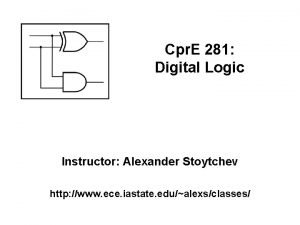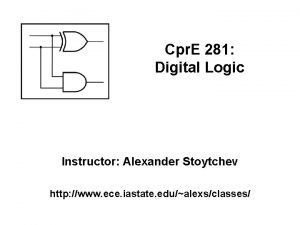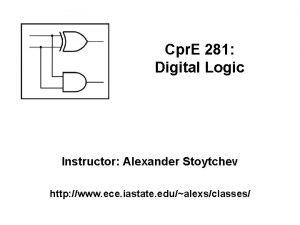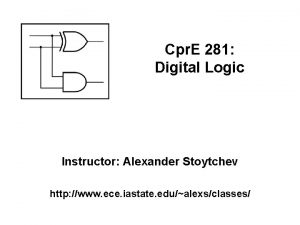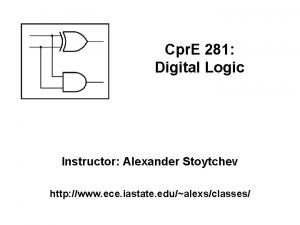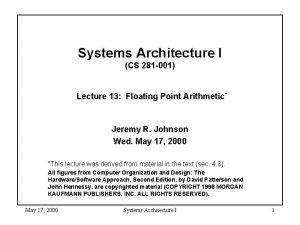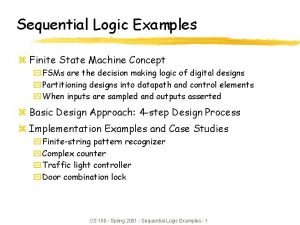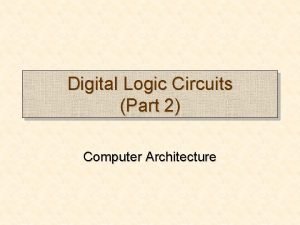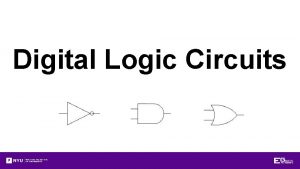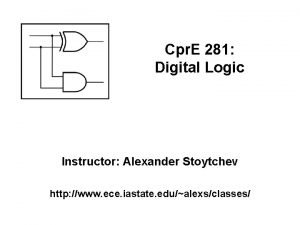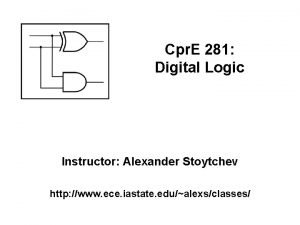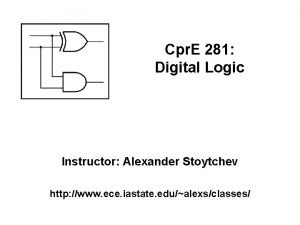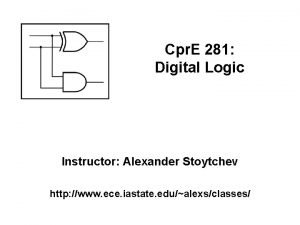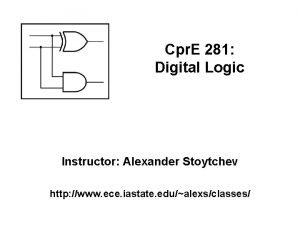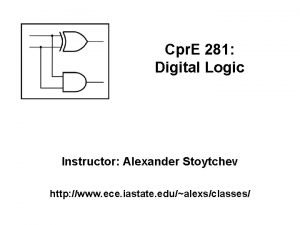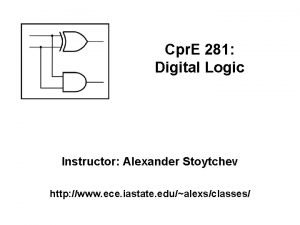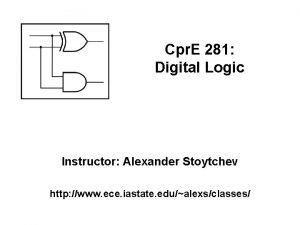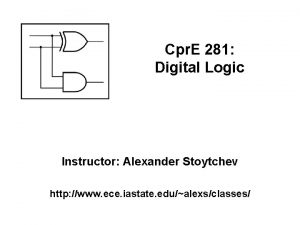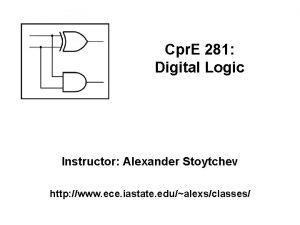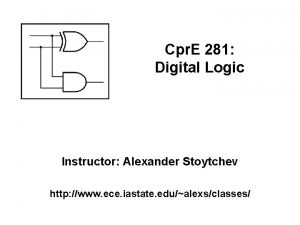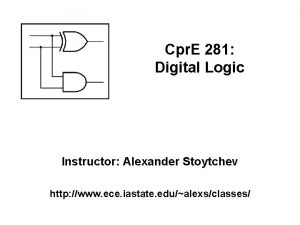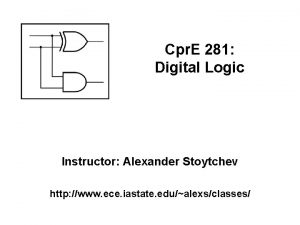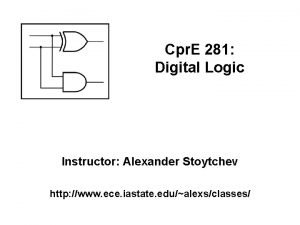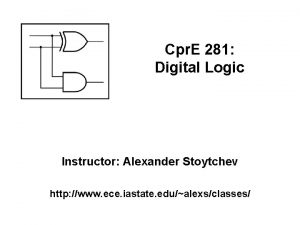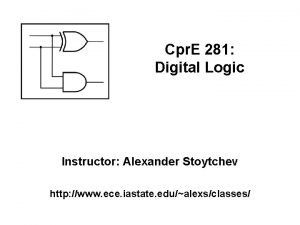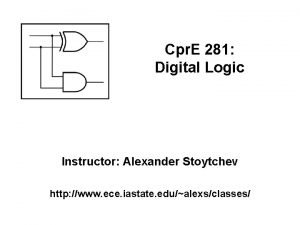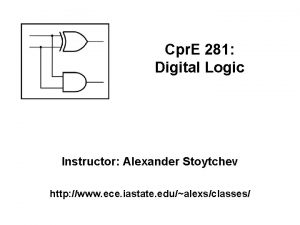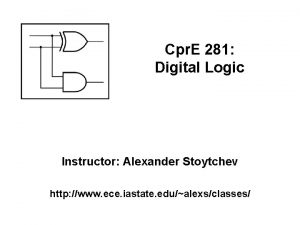Cpr E 281 Digital Logic Instructor Alexander Stoytchev




![A shifter circuit [ Figure 4. 50 from the textbook ] A shifter circuit [ Figure 4. 50 from the textbook ]](https://slidetodoc.com/presentation_image_h2/7398568bfce903c5f4ff709b4e0a69cc/image-5.jpg)
![A barrel shifter circuit [ Figure 4. 51 from the textbook ] A barrel shifter circuit [ Figure 4. 51 from the textbook ]](https://slidetodoc.com/presentation_image_h2/7398568bfce903c5f4ff709b4e0a69cc/image-6.jpg)







![A simple memory element A B [ Figure 5. 2 from the textbook ] A simple memory element A B [ Figure 5. 2 from the textbook ]](https://slidetodoc.com/presentation_image_h2/7398568bfce903c5f4ff709b4e0a69cc/image-14.jpg)

![A Strange Loop [http: //animalsiadmire. blogspot. com/2011/07/stupid-snake-eating-itself. html] A Strange Loop [http: //animalsiadmire. blogspot. com/2011/07/stupid-snake-eating-itself. html]](https://slidetodoc.com/presentation_image_h2/7398568bfce903c5f4ff709b4e0a69cc/image-16.jpg)
























![The Basic Latch Q [ Figure 5. 3 from the textbook ] The Basic Latch Q [ Figure 5. 3 from the textbook ]](https://slidetodoc.com/presentation_image_h2/7398568bfce903c5f4ff709b4e0a69cc/image-41.jpg)






















































![Single Pole, Double Throw = SPDT [http: //electronicsclub. info/images/swabc. gif] Single Pole, Double Throw = SPDT [http: //electronicsclub. info/images/swabc. gif]](https://slidetodoc.com/presentation_image_h2/7398568bfce903c5f4ff709b4e0a69cc/image-96.jpg)
![Single Pole, Double Throw = SPDT [http: //www. cubisteffects. com/images/MIY/Pt 3_Throw. jpg] Single Pole, Double Throw = SPDT [http: //www. cubisteffects. com/images/MIY/Pt 3_Throw. jpg]](https://slidetodoc.com/presentation_image_h2/7398568bfce903c5f4ff709b4e0a69cc/image-97.jpg)



![A Simple Circuit [ Platt 2009 ] A Simple Circuit [ Platt 2009 ]](https://slidetodoc.com/presentation_image_h2/7398568bfce903c5f4ff709b4e0a69cc/image-101.jpg)
![Let’s Take a Closer Look at This [ Platt 2009 ] Let’s Take a Closer Look at This [ Platt 2009 ]](https://slidetodoc.com/presentation_image_h2/7398568bfce903c5f4ff709b4e0a69cc/image-102.jpg)
![A Similar Example with NAND Gates [ Platt 2009 ] A Similar Example with NAND Gates [ Platt 2009 ]](https://slidetodoc.com/presentation_image_h2/7398568bfce903c5f4ff709b4e0a69cc/image-103.jpg)


- Slides: 105

Cpr. E 281: Digital Logic Instructor: Alexander Stoytchev http: //www. ece. iastate. edu/~alexs/classes/

Latches Cpr. E 281: Digital Logic Iowa State University, Ames, IA Copyright © Alexander Stoytchev

Administrative Stuff • HW 7 is due today

Some Final Things from Chapter 4
![A shifter circuit Figure 4 50 from the textbook A shifter circuit [ Figure 4. 50 from the textbook ]](https://slidetodoc.com/presentation_image_h2/7398568bfce903c5f4ff709b4e0a69cc/image-5.jpg)
A shifter circuit [ Figure 4. 50 from the textbook ]
![A barrel shifter circuit Figure 4 51 from the textbook A barrel shifter circuit [ Figure 4. 51 from the textbook ]](https://slidetodoc.com/presentation_image_h2/7398568bfce903c5f4ff709b4e0a69cc/image-6.jpg)
A barrel shifter circuit [ Figure 4. 51 from the textbook ]

Chapter 5

Terminology • Basic Latch – is a feedback connection of two NOR gates or two NAND gates, which can store one bit of information. It can be set using the S input and reset to 0 using the R input. • Gated Latch – is a basic latch that includes input gating and a control input signal. The latch retains its existing state when the control input is equal to 0. Its state may be changed when the control signal is equal to 1. [ Section 5. 7 in the textbook ]

Terminology • Two types of gated latches (the control input is the clock): • Gated SR Latch – uses the S and R inputs to set the latch to 1 or reset it to 0. • Gated D Latch – uses the D input to force the latch into a state that has the same logic value as the D input. [ Section 5. 7 in the textbook ]

Terminology • Flip-Flop – is a storage element that can have its output state changed only on the edge of the controlling clock signal. • Positive-edge triggered – if the state changes when the clock signal goes from 0 to 1. • Negative-edge triggered – if the state changes when the clock signal goes from 1 to 0. [ Section 5. 7 in the textbook ]

Terminology The word latch is mainly used for storage elements, while clocked devices are described as flip-flops. A latch is level-sensitive, whereas a flip-flop is edgesensitive. That is, when a latch is enabled it becomes transparent, while a flip flop's output only changes on a single type (positive going or negative going) of clock edge. [http: //en. wikipedia. org/wiki/Flip-flop_(electronics)]

Control of an alarm system Sensor Reset Set Memory element On ¤ Off Alarm [ Figure 5. 1 from the textbook ]

Motivation So far, our circuits have just been converting inputs to outputs. To do more advanced things (i. e. to make computers) we need components that can store data. Can we make a component that “remembers” from the components that we know?
![A simple memory element A B Figure 5 2 from the textbook A simple memory element A B [ Figure 5. 2 from the textbook ]](https://slidetodoc.com/presentation_image_h2/7398568bfce903c5f4ff709b4e0a69cc/image-14.jpg)
A simple memory element A B [ Figure 5. 2 from the textbook ]

A simple memory element with NOT Gates x x x
![A Strange Loop http animalsiadmire blogspot com201107stupidsnakeeatingitself html A Strange Loop [http: //animalsiadmire. blogspot. com/2011/07/stupid-snake-eating-itself. html]](https://slidetodoc.com/presentation_image_h2/7398568bfce903c5f4ff709b4e0a69cc/image-16.jpg)
A Strange Loop [http: //animalsiadmire. blogspot. com/2011/07/stupid-snake-eating-itself. html]

Building a NOT Gate with NAND x x x 0 1 x 1 0 x x x 0 0 1 1 x 0 1 f 1 1 1 0 Thus, the two truth tables are equal! impossible combinations

A simple memory element with NAND Gates x x x

Building a NOT Gate with NOR x x x 0 1 x 1 0 x x x 0 0 1 1 x 0 1 f 1 0 0 0 Thus, the two truth tables are equal! impossible combinations

A simple memory element with NOR Gates x x x

Basic Latch

A simple memory element with NOR Gates

A simple memory element with NOR Gates

A simple memory element with NOR Gates Set Reset

A memory element with NOR gates Reset Set Q [ Figure 5. 3 from the textbook ]

Two Different Ways to Draw the Same Circuit [ Figure 5. 3 & 5. 4 from the textbook ]

Before We Analyze the Basic Latch Let's Look at a Two Simpler Examples with Feedback

Let’s Try to Analyze This Circuit x f

Let’s Try to Analyze This Circuit Control Line x Data Line f

Let’s Try to Analyze This Circuit x ft ft+1 x ft 0 0 0 1 1 ft+1

Let’s Try to Analyze This Circuit x ft ft+1 0 0 1 0 1 0 0 1 1 0 If x = 0, then f is negated. If x = 1, then f is driven to 0.

Key Observation x f If a NOR’s control line is 0, then that NOR just negates its data line. If the control line is 1, then the NOR's output is driven to 0, ignoring its data line.

Let’s Try to Analyze This Circuit x g

Let’s Try to Analyze This Circuit x gt gt+1 x gt 0 0 0 1 1 gt+1

Let’s Try to Analyze This Circuit x gt gt+1 0 0 1 1 1 0 If x = 0, then g is driven to one. If x = 1, then g is negated.

Key Observation x g If a NAND’s control line is 1, then that NAND just negates its data line. If the control line is 0, then the NAND's output is driven to 1, ignoring its data line.

Output Oscillations What would happen to g if we keep x=1 for a long time? x g

Output Oscillations What would happen to g if we keep x=1 for a long time? x g 1 0 Time

Output Oscillations What would happen to g if we keep x=1 for a long time? tpd x g 1 0 tpd Time tpd is the propagation delay through the NAND gate, which is small, but not zero.

Back to the Basic Latch
![The Basic Latch Q Figure 5 3 from the textbook The Basic Latch Q [ Figure 5. 3 from the textbook ]](https://slidetodoc.com/presentation_image_h2/7398568bfce903c5f4ff709b4e0a69cc/image-41.jpg)
The Basic Latch Q [ Figure 5. 3 from the textbook ]

The Basic Latch Control Lines Q Data Lines Two of the previous NOR memory elements put togetter so that the data is flipped twice. [ Figure 5. 3 from the textbook ]

Analyzing The Basic Latch R Qa S Qb S 0 0 1 1 Qa Qb = NOR (S, Qa) 0 1 R 0 0 1 1 Qb Qa = NOR (R, Qb) 0 1

Analyzing The Basic Latch R Qa S Qb S 0 0 1 1 Qa Qb = NOR (S, Qa) 1 0 0 0 1 R 0 0 1 1 Qb Qa = NOR (R, Qb) 1 0 0 0 1

Analyzing The Basic Latch R Qa S Qb S 0 1 Qb Qa 0 R 0 1 Qa Qb 0

Behavior of the Basic Latch R Q S S R 0 0 0 1 1 Qt+1

Behavior of the Basic Latch R Q S S R Qt+1 0 0 Qt 0 1 0 1 1 1 0

Behavior of the Basic Latch R Qa S Qb S R 0 0 0 1 1 Qa(t+1) Qb(t+1)

Behavior of the Basic Latch R Qa S Qb S R Qa(t+1) Qb(t+1) 0 0 Qa(t) Qb(t) 0 1 0 1 1 0 0

Behavior of the Basic Latch R Qa S Qb S R Qa(t+1) Qb(t+1) 0 0 Qa(t) Qb(t) Latch 0 1 Reset 1 0 Set 1 1 0 0 Undesirable

Circuit and Characteristic Table R Qa Qb S (a) Circuit S R Qa Qb 0 0 0/1 1/0 (no change) 0 1 0 1 1 0 0 (b) Characteristic table [ Figure 5. 4 a, b from the textbook ] NOR Gate Truth table x 1 0 0 1 1 x 2 0 1 f 1 0 0 0

Circuit and Characteristic Table R Qa Qb S (a) Circuit S R Qa Qb 0 0 0/1 1/0 (no change) 0 1 0 1 1 0 0 (b) Characteristic table A truth table should take the state into account. Thus, characteristic table, which takes only the inputs into account. NOR Gate [ Figure 5. 4 a, b from the textbook ] NOR Gate Truth table x 1 0 0 1 1 x 2 0 1 f 1 0 0 0

Oscillations and Undesirable States • When both S=1 and R=1 both outputs of the latch are equal to 0, i. e. , Qa=0 and Qb=0. • Thus, the two outputs are no longer complements of each other. • This is undesirable as many of the circuits that we will build later with these latches rely on the assumption that the two outputs are always complements of each other. • (This is obviously not the case for the basic latch, but we will patch it later to eliminate this problem).

Oscillations and Undesirable States • An even bigger problem occurs when we transition from S=R=1 to S=R=0. • When S=R=1 we have Qa=Qb=0. After the transition to S=R=0, however, we get Qa=Qb=1, which would immediately cause Qa=Qb=0, and so on. • If the gate delays and the wire lengths are identical, then this oscillation will continue forever. • In practice, the oscillation dies down and the output settles into either Qa=1 and Qb=0 or Qa=0 and Qb=1. • The problem is that we can't predict which one of these two it will settle into.

Timing Diagram for the Basic Latch with NOR Gates R Qa Qb S (a) Circuit t 1 t 2 S R Qa Qb 0 0 0/1 1/0 (no change) 0 1 0 1 1 0 0 (b) Characteristic table t 3 t 4 t 5 t 6 t 7 t 8 t 9 t 10 1 R 0 1 S Qa Qb 0 1 ? 0 Time (c) Timing diagram [ Figure 5. 4 from the textbook ]

Timing Diagram for the Basic Latch with NOR Gates R Qa Qb S (a) Circuit t 1 t 2 S R Qa Qb 0 0 0/1 1/0 (no change) 0 1 0 1 1 0 0 (b) Characteristic table t 3 t 4 t 5 t 6 t 7 t 8 t 9 t 10 1 R 0 1 S Qa Qb 0 1 ? 0 Time (c) Timing diagram [ Figure 5. 4 from the textbook ]

Timing Diagram for the Basic Latch with NOR Gates R Qa Qb S (a) Circuit t 1 t 2 S R Qa Qb 0 0 0/1 1/0 (no change) 0 1 0 1 1 0 0 (b) Characteristic table t 3 t 4 t 5 t 6 t 7 t 8 t 9 t 10 1 R 0 1 S Qa Qb 0 1 ? 0 Time (c) Timing diagram [ Figure 5. 4 from the textbook ]

Timing Diagram for the Basic Latch with NOR Gates R Qa Qb S (a) Circuit t 1 t 2 S R Qa Qb 0 0 0/1 1/0 (no change) 0 1 0 1 1 0 0 (b) Characteristic table t 3 t 4 t 5 t 6 t 7 t 8 t 9 t 10 1 R 0 1 S Qa Qb 0 1 ? 0 Time (c) Timing diagram

Timing Diagram for the Basic Latch with NOR Gates R Qa Qb S (a) Circuit t 1 t 2 S R Qa Qb 0 0 0/1 1/0 (no change) 0 1 0 1 1 0 0 (b) Characteristic table t 3 t 4 t 5 t 6 t 7 t 8 t 9 A transition from S=R=1 to S=R=0 causes oscillations of the two output values Qa and Qb. t 10 1 R 0 1 S Qa Qb 0 1 ? 0 Time (c) Timing diagram

Basic Latch with NAND Gates

Circuit for the Basic Latch with NAND Gates

Basic Latch (with NOR Gates) (with NAND Gates) Notice that in the NAND case the two inputs are swapped and negated. The labels of the outputs are the same in both cases.

Basic Latch (with NOR Gates) (with NAND Gates) SR Latch

Circuit and Characteristic Table S Qa Qb R (a) Circuit NAND Gate S R 0 0 0 Qa Qb S R Qa Qb 0/1 1/0 (no change) 1 0 0 0 1 1 1 0 0 1 1 1 0/1 1/0 (no change) (b) Characteristic table (version 1) (c) Characteristic table (version 2) NAND Gate Truth table x 1 0 0 1 1 x 2 0 1 f 1 1 1 0

Basic Latch (with NOR Gates) (with NAND Gates) S R Qa Qb 0 0 0/1 1/0 (no change) 0 1 0 1 1 0 0 1 1

Basic Latch (with NOR Gates) (with NAND Gates) S R Qa Qb 0 0 0/1 1/0 (no change) 0 1 0 1 1 0 0 Latch Reset Set Undesirable S R Qa Qb 0 0 0/1 1/0 (no change)Latch 0 1 0 1 1 1 1 Reset Set Undesirable

Basic Latch (with NOR Gates) (with NAND Gates) S R Qa Qb 0 0 0/1 1/0 (no change) 0 1 0 1 1 0 0 Latch Reset Set Undesirable S R Qa Qb 0 0 0/1 1/0 (no change)Latch 0 1 0 1 1 1 1 Reset Set Undesirable The two characteristic tables are the same (except for the last row, which is the undesirable configuration).

Oscillations and Undesirable States • The basic latch with NAND gates also suffers form oscillation problems, similar to the basic latch implemented with NOR gates. • Try to do this analysis on your own.

Gated SR Latch

Motivation • The basic latch changes its state when the input signals change • It is hard to control when these input signals will change and thus it is hard to know when the latch may change its state. • We want to have something like an Enable input • In this case it is called the “Clock” input because it is desirable for the state changes to be synchronized

Circuit Diagram for the Gated SR Latch [ Figure 5. 5 a from the textbook ]

Circuit Diagram for the Gated SR Latch This is the “gate” of the gated latch

Circuit Diagram for the Gated SR Latch Notice that these are complements of each other

Circuit Diagram and Characteristic Table for the Gated SR Latch [ Figure 5. 5 a-b from the textbook ]

Circuit Diagram and Graphical Symbol for the Gated SR Latch [ Figure 5. 5 a, c from the textbook ]

Timing Diagram for the Gated SR Latch [ Figure 5. 5 c from the textbook ]

Gated SR latch with NAND gates S Q Clk Q R [ Figure 5. 6 from the textbook ]

Gated SR latch with NAND gates S Q Clk Q R In this case the “gate” is constructed using NAND gates! Not AND gates.

Gated SR latch with NAND gates S Q Clk Q R Also, notice that the positions of S and R are now swapped.

Gated SR latch with NAND gates S S Q 1 Clk = 1 1 R Q R Finally, notice that when Clk=1 this turns into the basic latch with NAND gates, i. e. , the SR Latch.

Gated SR latch with NOR gates Gated SR latch with NAND gates S Q Clk Q R

Gated SR latch with NOR gates Gated SR latch with NAND gates S Q Clk Q R Graphical symbols are the same

Gated SR latch with NOR gates (undesirable) Gated SR latch with NAND gates S Q Clk Q R (undesirable) Characteristic tables are the same

Gated D Latch

Motivation • Dealing with two inputs (S and R) could be messy. For example, we may have to reset the latch before some operations in order to store a specific value but the reset may not be necessary depending on the current state of the latch. • Why not just have one input and call it D. • The D latch can be constructed using a simple modification of the SR latch.

Circuit Diagram for the Gated D Latch [ Figure 5. 7 a from the textbook ]

Circuit Diagram for the Gated D Latch This is the only new thing here. [ Figure 5. 7 a from the textbook ]

Circuit Diagram and Characteristic Table for the Gated D Latch Note that it is now impossible to have S=R=1. [ Figure 5. 7 a, b from the textbook ]

Circuit Diagram and Characteristic Table for the Gated D Latch When Clk=1 the output follows the D input. When Clk=0 the output cannot be changed. [ Figure 5. 7 a, b from the textbook ]

Circuit Diagram and Graphical Symbol for the Gated D Latch [ Figure 5. 7 a, c from the textbook ]

Timing Diagram for the Gated D Latch [ Figure 5. 7 d from the textbook ]

Setup and hold times t su th Clk D Q Setup time (tsu) – the minimum time that the D signal must be stable prior to the negative edge of the Clock signal Hold time (th) – the minimum time that the D signal must remain stable after the negative edge of the Clock signal [ Figure 5. 8 from the textbook ]

Some Practical Examples

Different Types of Switches http: //www. industrial-electronics. com/Electricity-Refrigeration-Heating-Air-Conditioning_5 b. html

Different Types of Switches If you are building a circuit with latches you’ll need to use this type of switch. http: //www. industrial-electronics. com/Electricity-Refrigeration-Heating-Air-Conditioning_5 b. html
![Single Pole Double Throw SPDT http electronicsclub infoimagesswabc gif Single Pole, Double Throw = SPDT [http: //electronicsclub. info/images/swabc. gif]](https://slidetodoc.com/presentation_image_h2/7398568bfce903c5f4ff709b4e0a69cc/image-96.jpg)
Single Pole, Double Throw = SPDT [http: //electronicsclub. info/images/swabc. gif]
![Single Pole Double Throw SPDT http www cubisteffects comimagesMIYPt 3Throw jpg Single Pole, Double Throw = SPDT [http: //www. cubisteffects. com/images/MIY/Pt 3_Throw. jpg]](https://slidetodoc.com/presentation_image_h2/7398568bfce903c5f4ff709b4e0a69cc/image-97.jpg)
Single Pole, Double Throw = SPDT [http: //www. cubisteffects. com/images/MIY/Pt 3_Throw. jpg]

Single-pole—single-throw manual switch http: //www. industrial-electronics. com/Electricity-Refrigeration-Heating-Air-Conditioning_5 b. html

Double-pole—double-throw manual switch http: //www. industrial-electronics. com/Electricity-Refrigeration-Heating-Air-Conditioning_5 b. html

The following examples came from this book
![A Simple Circuit Platt 2009 A Simple Circuit [ Platt 2009 ]](https://slidetodoc.com/presentation_image_h2/7398568bfce903c5f4ff709b4e0a69cc/image-101.jpg)
A Simple Circuit [ Platt 2009 ]
![Lets Take a Closer Look at This Platt 2009 Let’s Take a Closer Look at This [ Platt 2009 ]](https://slidetodoc.com/presentation_image_h2/7398568bfce903c5f4ff709b4e0a69cc/image-102.jpg)
Let’s Take a Closer Look at This [ Platt 2009 ]
![A Similar Example with NAND Gates Platt 2009 A Similar Example with NAND Gates [ Platt 2009 ]](https://slidetodoc.com/presentation_image_h2/7398568bfce903c5f4ff709b4e0a69cc/image-103.jpg)
A Similar Example with NAND Gates [ Platt 2009 ]

Questions?

THE END
 Stoytchev 281
Stoytchev 281 Stoytchev 281
Stoytchev 281 Cpr e 281
Cpr e 281 Stoytchev
Stoytchev Stoytchev
Stoytchev Coral phone system
Coral phone system Cs 281 wordpress
Cs 281 wordpress It is a circular or elliptical anticlinal structure
It is a circular or elliptical anticlinal structure Granite weathering
Granite weathering 281-284-0027
281-284-0027 Cs 281
Cs 281 Nmeros romanos
Nmeros romanos Dönem ayırıcı hesaplar örnek
Dönem ayırıcı hesaplar örnek Dönem ayirici hesaplar 180 181 280 281 380 381
Dönem ayirici hesaplar 180 181 280 281 380 381 First order logic vs propositional logic
First order logic vs propositional logic First order logic vs propositional logic
First order logic vs propositional logic Third order logic
Third order logic Combinational logic circuit vs sequential
Combinational logic circuit vs sequential Tw
Tw Project management plan example
Project management plan example Combinational logic sequential logic
Combinational logic sequential logic Combinational logic sequential logic 차이
Combinational logic sequential logic 차이 If x = 0 and y = 1, which output line is enabled?
If x = 0 and y = 1, which output line is enabled? Digital logic design tutorial
Digital logic design tutorial Is a multiplexer a state machine
Is a multiplexer a state machine Timing diagram for nor gate
Timing diagram for nor gate Digital system design
Digital system design Digital logic controller
Digital logic controller Canonical form digital logic
Canonical form digital logic Digital logic design practice problems
Digital logic design practice problems Precedence of logic gates
Precedence of logic gates Digital logic design lectures
Digital logic design lectures Digital logic structures
Digital logic structures Consensus theorem
Consensus theorem Bubble matching digital logic
Bubble matching digital logic Digital logic and computer architecture
Digital logic and computer architecture Uncommon logic digital
Uncommon logic digital Digital design
Digital design Duality in discrete mathematics
Duality in discrete mathematics Digital logic design
Digital logic design Bubble matching digital logic
Bubble matching digital logic Tipos de participantes en un curso
Tipos de participantes en un curso Tcole instructor course
Tcole instructor course Basic instructor course texas
Basic instructor course texas Basic instructor course texas
Basic instructor course texas Pepperball hotshot
Pepperball hotshot Subject verb agreement exercise
Subject verb agreement exercise Instructor vs teacher
Instructor vs teacher Cisco certified trainer
Cisco certified trainer Mptc firearms instructor manual
Mptc firearms instructor manual Basic instructor course #1014
Basic instructor course #1014 Basic instructor course #1014
Basic instructor course #1014 Virtual instructor.com
Virtual instructor.com Nfpa 1403
Nfpa 1403 Human factors instructor
Human factors instructor Instructor operating station
Instructor operating station Catia instructor
Catia instructor Instructor
Instructor Instructor responsibilities and professionalism
Instructor responsibilities and professionalism Tcole 1014 basic instructor course
Tcole 1014 basic instructor course Usmc jrotc vacancies
Usmc jrotc vacancies Nrp instructor toolkit
Nrp instructor toolkit Utp cable
Utp cable Wisconsin cbrf registry
Wisconsin cbrf registry Nra certified instructor logo
Nra certified instructor logo Naismith was an instructor of
Naismith was an instructor of Please clean your room
Please clean your room Tcole advanced instructor course
Tcole advanced instructor course Tcole advanced instructor course
Tcole advanced instructor course Jrotc marksmanship instructor course online
Jrotc marksmanship instructor course online Which line is longer illusion
Which line is longer illusion Cyan medical terminology
Cyan medical terminology Basic instructor course #1014
Basic instructor course #1014 Basic instructor course tcole
Basic instructor course tcole Delmar cengage learning instructor resources
Delmar cengage learning instructor resources Instructor office hours
Instructor office hours Extracorporeal cpr
Extracorporeal cpr 3 prinsip sebelum cpr kecuali
3 prinsip sebelum cpr kecuali Perbedaan cpr dan mpr
Perbedaan cpr dan mpr Pediatric bls algorithm
Pediatric bls algorithm Objective of cpr
Objective of cpr Objectives of cpr
Objectives of cpr Secondary survey definition
Secondary survey definition Llf cpr
Llf cpr Ems safety cpr
Ems safety cpr Emotional cpr pdf
Emotional cpr pdf Cpr hand placement sternum
Cpr hand placement sternum For adult
For adult American heart association recommends child cpr for
American heart association recommends child cpr for Pulse check in child cpr
Pulse check in child cpr Sexnrace
Sexnrace Dyrektywa cpr
Dyrektywa cpr Cpr in physical education
Cpr in physical education Cpr compression rate
Cpr compression rate Types of cpr
Types of cpr Do not start cpr in the following situations:
Do not start cpr in the following situations: Push hard push fast fully recoil
Push hard push fast fully recoil Cpr bydgoszcz
Cpr bydgoszcz Introduction of cpr
Introduction of cpr Cpr adrenaline dose
Cpr adrenaline dose American heart association cpr in schools
American heart association cpr in schools 4 r's of cpr
4 r's of cpr Carta pertolongan cemas
Carta pertolongan cemas Resuscitation cpr
Resuscitation cpr Cpr vocabulary
Cpr vocabulary What is high quality cpr
What is high quality cpr
